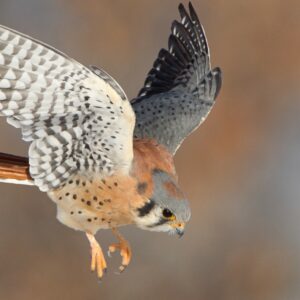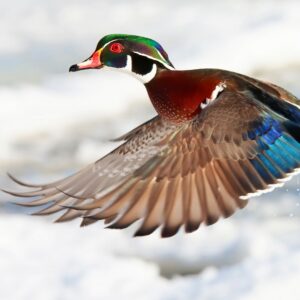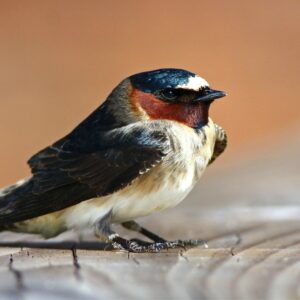Osprey: Raptor Masterful at Fishing, With a Unique Edge
The osprey is a large hawk with relatively long and narrow wings with a bend at the wrist that gives this bird a distinctive shape. Ospreys live and hunt around water. The osprey has a mix of white and brown feathers, the underside of its body and wings are mostly white, with a few brown spots, and the top of its wings are mostly brown. The white crown and throat divided by a heavy brown eye line makes an unmistakable facial pattern. The sexes appear nearly identical, though the male is smaller, as is the case with most raptors.
Skillful at fishing, with a twist
The osprey is well known for its ability to catch fish. It will circle a body of water looking for a fish to catch, occasionally hovering in a stationary position before diving into the water to grab the fish with its claws. The osprey has a reversible outer toe and barbed feet pads to secure its slippery prey as it emerges from the water. Their dives are usually successful 25% to 70% of the time, and so they eat live fish almost exclusively.
Snowbirding and a penchant for a room with a view
During the summer months, the osprey’s breeding grounds span parts of Alaska and the northern United States, as well as all Canadian provinces and territories, including Nunavut, where it is on the edge of its breeding range. When fall arrives, ospreys migrate to the southern United States, Mexico, Central America and the northern half of South America, where it occupies large wetlands and river systems.
Always close to water, most osprey nests are near the top of large trees. In the absence of large trees, they often make their nests on built structures like utility poles or cell towers. The female lays 2 to 4 eggs per year that take, on average, 38 days to hatch. Once hatched, the young osprey learns to fly after about 51 to 54 days.
Future outlook and concerns
The current population is stable or even growing in Canada, attesting to concerted conservation efforts to recover this and other species, in particular by banning certain pesticides and protecting them from persecution. However, like many different species of aquatic birds, threats to aquatic ecosystems like droughts and water pollution can negatively affect prey populations and lead to a decrease in osprey numbers. In addition, due to some forestry practices that lead to the removal of large trees, the osprey is increasingly reliant on built structures for nesting. Unfortunately, adult ospreys sometimes incorporate different plastics in their nest that can end up entangling a chick’s foot and injure it. Due to this, they are one of the species that are most affected by plastic pollution.
Canada has identified the osprey as a priority for conservation and stewardship strategies in the hopes of maintaining their current numbers. Advocating for the conservation of wetlands in Canada, a reduction in single-use plastics, and conserving nature, in general, are great ways to support the osprey.
Want to help Canadian species like the osprey and more? Stay tuned with the latest in Canadian nature by subscribing for email updates. You’ll receive regular updates about what we’re doing to protect Canadian nature and how you can help.
Sources:
https://naturecanada.ca/news/blog/get-to-know-this-years-featured-world-migratory-bird-day-species-osprey/
https://www.allaboutbirds.org/guide/Osprey/overview
Correction Notice:
An earlier version of this article indicated, “Male and female ospreys look identical for the most part, with the smaller size of the females being the most noticeable difference.” We have made an update to correct the error: “The sexes appear nearly identical, though the male is smaller, as is the case with most raptors.”



